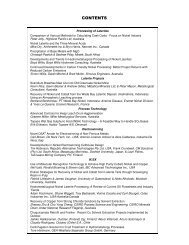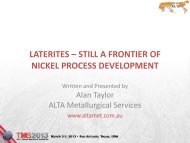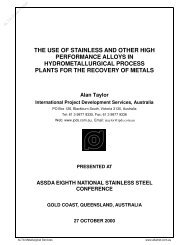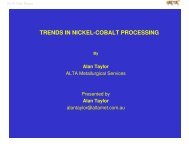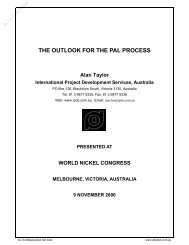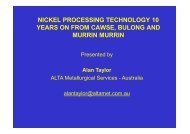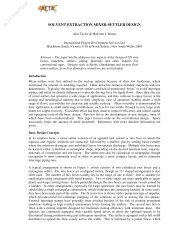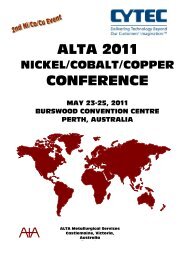what's happening in copper hydromet - ALTA Metallurgical Services
what's happening in copper hydromet - ALTA Metallurgical Services
what's happening in copper hydromet - ALTA Metallurgical Services
Create successful ePaper yourself
Turn your PDF publications into a flip-book with our unique Google optimized e-Paper software.
WHAT’S HAPPENING IN COPPER HYDROMET<br />
Presented by<br />
Alan Taylor<br />
<strong>ALTA</strong> <strong>Metallurgical</strong> <strong>Services</strong>, Melbourne<br />
alantaylor@altamet.com.au<br />
AusIMM Melbourne Technical Meet<strong>in</strong>g, September 2013
INTRODUCTION<br />
Copper <strong>hydromet</strong>allurgical technology is cont<strong>in</strong>u<strong>in</strong>g to<br />
develop and expand for the treatment of <strong>copper</strong> oxide and<br />
sulphide ores and concentrates.<br />
2
KEY DRIVERS<br />
• The emergence of SX-EW as a robust, relatively low-tech,<br />
process for selectively extract<strong>in</strong>g <strong>copper</strong> from sulphuric acid<br />
leach solutions and produc<strong>in</strong>g Grade A cathode product.<br />
• The availability of extensive high grade oxide <strong>copper</strong> and<br />
<strong>copper</strong>/cobalt ore deposits <strong>in</strong> the Central African Copperbelt.<br />
• The successful large scale treatment of oxide ores by heap<br />
leach<strong>in</strong>g and secondary sulphide ores by heap bio-leach<strong>in</strong>g.<br />
• The need for an economic process for treat<strong>in</strong>g low grade and<br />
complex primary sulphide ores.<br />
• The desirability of produc<strong>in</strong>g a high grade <strong>copper</strong> product at site,<br />
especially for small, medium and remote sulphide ore m<strong>in</strong>es.<br />
•<br />
3
KEY DRIVERS (CONT.)<br />
• The need for an alternative to smelt<strong>in</strong>g for concentrates with<br />
significant levels of undesirable impurities such as arsenic.<br />
• The successful application of <strong>hydromet</strong>allurgical processes such<br />
as pressure oxidation and bio-oxidation for the treatment of gold<br />
and z<strong>in</strong>c ores and concentrates.<br />
• Increas<strong>in</strong>gly str<strong>in</strong>gent environmental regulations for smelter<br />
off-gases.<br />
4
CHALLENGES<br />
• High energy consumption of electrow<strong>in</strong>n<strong>in</strong>g from sulphate<br />
solutions<br />
• Volatility <strong>in</strong> the availability and price of elemental sulphur and<br />
sulphuric acid.<br />
• High transport cost for reagents to remote sites, especially<br />
sulphuric acid.<br />
• Slow leach<strong>in</strong>g k<strong>in</strong>etics and low recovery from primary sulphides<br />
such as chalcopyrite with sulphuric acid solutions at atmospheric<br />
temperature due to the formation of a passivation layer.<br />
• Precious metals recovery from leach residues.<br />
5
CHALLENGES (CONT.)<br />
• High cost for regenerat<strong>in</strong>g and recycl<strong>in</strong>g alternative lixiviants<br />
such as hydrochloric acid.<br />
• Unfamiliarity of m<strong>in</strong><strong>in</strong>g <strong>in</strong>dustry with alternative lixiviants.<br />
• High risk factor <strong>in</strong> the application of new technology.<br />
• Lack of skilled labour and support services at remote m<strong>in</strong>e sites.<br />
6
AREAS OF DEVELOPMENTS<br />
• A resurgence of atmospheric agitated tank sulphuric acid<br />
leach<strong>in</strong>g circuits for high grade oxide <strong>copper</strong> and <strong>copper</strong>/cobalt<br />
ores.<br />
• Application of high temperature atmospheric agitated tank acidic<br />
ferric sulphate leach<strong>in</strong>g of secondary sulphide ores.<br />
• Extension of heap bio-leach<strong>in</strong>g to low grade chalcopyrite ores.<br />
• Development of a variety of <strong>hydromet</strong> treatment processes for<br />
<strong>copper</strong> sulphide concentrates.<br />
• Developments <strong>in</strong> SX and EW.<br />
7
AGITATED TANK SULPHURIC ACID LEACHING<br />
OF OXIDE ORES<br />
• S<strong>in</strong>ce 1960s, has been largely displaced by lower cost heap<br />
leach<strong>in</strong>g.<br />
• However, there has been a recent resurgence for <strong>copper</strong> and<br />
<strong>copper</strong>/cobalt projects <strong>in</strong> the Central African Copperbelt due to:<br />
– Higher grade ores able to support higher capex and opex<br />
– Higher recovery<br />
– Short testwork program<br />
– Relatively fast ramp-up time<br />
– Reliable scale-up and lower technical risk<br />
– Need to reduce cobalt m<strong>in</strong>erals.<br />
• Numerous projects <strong>in</strong> DRC and Zambia.<br />
8
TENKE FUNGURUME FLOWSHEET, FCX, DRC<br />
(Ref: Tenke M<strong>in</strong><strong>in</strong>g Corp. presentation March 2006)<br />
9
TENKE FUNGURUME OPERATION, FCX, DRC<br />
(Ref: Freeport McMoRan conference presentation, 2009)<br />
10
AGITATED TANK ACIDIC FERRIC SULPHATE LEACHING<br />
OF SECONDARY SULPHIDE ORES<br />
• Typically applied to high grade secondary sulphide and mixed<br />
sulphide/oxide ores. (Heap bio-leach<strong>in</strong>g is commonly used for<br />
lower grade ores.)<br />
• Operations:<br />
- Sepon, MMG, Laos<br />
- Las Cruces, First Quantum, Spa<strong>in</strong><br />
- Mt Gordon, QLD, now closed.<br />
• The ferric iron level is ma<strong>in</strong>ta<strong>in</strong>ed by oxygen <strong>in</strong>jection or<br />
pressure oxidation.<br />
• Typically operates at high temperature; cool<strong>in</strong>g ahead of SX.<br />
11
SEPON FLOWSHEET, MMG, DRC<br />
(Ref: David Dreis<strong>in</strong>ger presentation, <strong>ALTA</strong> 2012)<br />
12
SEPON OPERATION, MMG, LAOS<br />
13
HEAP BIO-LEACHING OF LOW GRADE CHALCOPYRITE<br />
• There are many <strong>copper</strong> primary sulphide deposits which cannot<br />
be economically treated by conventional means due to low<br />
grade or problem impurities.<br />
• Heap leach<strong>in</strong>g us<strong>in</strong>g common iron oxidiz<strong>in</strong>g bacteria, ambient<br />
temperature and conventional techniques results <strong>in</strong> very slow<br />
leach<strong>in</strong>g rate and low recovery, due to a passivation layer.<br />
• Recovery is typically limited to about 30% <strong>in</strong> 3-5 years though<br />
there are some more reactive orebodies.<br />
• A number of organizations are undertak<strong>in</strong>g development<br />
programs <strong>in</strong>clud<strong>in</strong>g BioHeap/Western Areas, Australia; M<strong>in</strong>tek,<br />
South Africa; BacTech, Canada; GeoBiotics, USA; BHP Billiton,<br />
Chile; BioSigma (Codelco/Nippon), Chile; Rio T<strong>in</strong>to, USA.<br />
• Strategies <strong>in</strong>clude development of special bacteria cultures,<br />
maximization of operat<strong>in</strong>g temperature, and optimization of<br />
irrigation patterns and aeration rates.<br />
14
MINTEK TEST HEAP AT DAREHZARE MINE, IRAN<br />
(Ref: M<strong>in</strong>tek paper, <strong>ALTA</strong> 2007)<br />
15
HYDROMET PROCESSES FOR SULPHIDE CONCENTRATES<br />
• Numerous processes have been tested over many years but only<br />
a few have been commercialized, with limited success.<br />
• Current processes under development <strong>in</strong>volve:<br />
– medium and high temperature pressure oxidation<br />
– atmospheric tank bio-oxidation<br />
– atmospheric tank galvanic leach<strong>in</strong>g<br />
– chloride leach<strong>in</strong>g.<br />
• Of these:<br />
– high temperature pressure oxidation has been commercialized<br />
– medium temperature pressure oxidation and tank bio-oxidation<br />
have reached small scale commercial or semi-commercial level<br />
– galvanic leach<strong>in</strong>g has reached pilot plant scale<br />
– chloride leach<strong>in</strong>g has reached pilot scale (though a<br />
commercial operation has been operated <strong>in</strong> the past).<br />
16
HIGH TEMPERATURE PRESSURE OXIDATION<br />
• Uses pressure oxidation with oxygen <strong>in</strong> an autoclave at<br />
200-225°C. Copper is solubilized as sulphate, iron precipitates<br />
as hematite. Sulphur forms metal sulphates and sulphuric acid.<br />
• Solid-liquid separation is carried out <strong>in</strong> CCD thickeners and/or<br />
filters.<br />
• Copper recovery from the clarified solution is by conventional<br />
SX/EW.<br />
• A raff<strong>in</strong>ate bleed is required to control the acid level <strong>in</strong> solution.<br />
The bleed stream is neutralized for disposal or used for leach<strong>in</strong>g<br />
associated oxide ore, for example by heap leach<strong>in</strong>g.<br />
• Well proven process for gold and z<strong>in</strong>c production.<br />
17
HIGH TEMPERATURE PRESSURE OXIDATION FLOWSHEET<br />
Oxygen<br />
Feed<br />
Concentrates<br />
PRESSURE<br />
OXIDATION<br />
Bleed to<br />
Neutralisation or<br />
Oxide Leach<strong>in</strong>g<br />
Raff<strong>in</strong>ate<br />
CCD CIRCUIT<br />
(Or Belt Filter)<br />
Solution<br />
COPPER SX<br />
Limestone<br />
Lime<br />
Residue<br />
to<br />
Tail<strong>in</strong>gs<br />
Solids<br />
NEUTRALISATION<br />
Cyanide<br />
GOLD<br />
RECOVERY<br />
COPPER EW<br />
COPPER CATHODES<br />
18
HIGH TEMPERATURE PRESSURE OXIDATION STATUS<br />
• Freeport McMoRan, built a semi-commercial plant at Bagdad<br />
Arizona, to treat 15% of Bagdad’s flotation concentrate output,<br />
which came on stream <strong>in</strong> 2003. The nom<strong>in</strong>al operat<strong>in</strong>g<br />
temperature is 225 o C with a retention time of 70 m<strong>in</strong>utes. The<br />
design <strong>copper</strong> recovery was 98%. The <strong>copper</strong> and acid<br />
produced are blended <strong>in</strong>to the exist<strong>in</strong>g low grade sulphide dump<br />
leach<strong>in</strong>g-SX-EW operation.<br />
• First Quantum <strong>in</strong>stalled a system at Kansanshi <strong>in</strong> Zambia to<br />
treat some of the flotation concentrate. The acid formed is<br />
utilized <strong>in</strong> oxide ore leach<strong>in</strong>g. Cathode <strong>copper</strong> is produced by<br />
SX-EW.<br />
19
FREEPORT MCMORAN PLANT, BAGDAD, ARIZONA<br />
20
MEDIUM TEMPERATURE PRESSURE OXIDATION<br />
• Uses pressure oxidation with oxygen <strong>in</strong> an autoclave at<br />
around 150°C with a leach time of 1-3 hours.<br />
• Forms elemental sulphur <strong>in</strong>stead of acid which reduces oxygen<br />
consumption and limestone needed for neutralization.<br />
• A surfactant is typically used to disperse the sulphur which is <strong>in</strong><br />
the liquid state<br />
• Be<strong>in</strong>g developed by a number of organizations <strong>in</strong>clud<strong>in</strong>g FCX,<br />
USA; Teck/CESL, Canada, Dynatec, Canada; Anglo American,<br />
South Africa.<br />
• Variations <strong>in</strong>clude ultraf<strong>in</strong>e gr<strong>in</strong>d<strong>in</strong>g (FCX, Anglo), chloride<br />
addition as a catalyst (Teck/CESL) and residue flotation to<br />
maximize recovery (Dynatec).<br />
21
MEDIUM TEMPERATURE PRESSURE OXIDATION<br />
STATUS<br />
• The FCX Process was commercialized at Morenci, <strong>in</strong> 2007.<br />
Overall <strong>copper</strong> recovery target was 97.5%. 90% of the <strong>copper</strong><br />
is produced by direct EW. The rema<strong>in</strong><strong>in</strong>g 10% is sent as a<br />
bleed stream for blend<strong>in</strong>g with heap leach solution for recovery<br />
by SX-EW.<br />
• A semi-commercial CESL Process facility was commissioned at<br />
Vale <strong>in</strong> Brazil <strong>in</strong> 2008.<br />
22
FCX MORENCI PROCESS FLOWSHEET<br />
23
FCX MORENCY AUTOCLAVES<br />
24
TANK BIO-OXIDATION<br />
• Uses extreme thermophile bio-oxidation <strong>in</strong> atmospheric agitated<br />
tanks at up to 70-80 o C.<br />
• Oxygen and nutrients are added. Oxygen efficiency is about 80%.<br />
• Liquid/solids separation/wash<strong>in</strong>g of the leach pulp is by<br />
CCD/filtration.<br />
• Copper recovery is via conventional SX/EW.<br />
• There is potential for maximiz<strong>in</strong>g acid production for leach<strong>in</strong>g of<br />
associated oxide ore, if available.<br />
• BioCOP Process is be<strong>in</strong>g developed by BHP Billiton.<br />
• A BioCOP semi-commercial plant was built near Chuquicamata, Chile,<br />
by BHP Billiton/Codelco to treat chalcopyrite/enargite concentrate <strong>in</strong><br />
2003. Plans for a commercial facility did not proceed, reportedly due to<br />
high costs and eng<strong>in</strong>eer<strong>in</strong>g issues.<br />
• Bactech/M<strong>in</strong>tek have developed a process us<strong>in</strong>g moderate thermophiles<br />
at 45-50 o C with ultraf<strong>in</strong>e gr<strong>in</strong>d<strong>in</strong>g up to demo. plant scale.<br />
25
BHP BILLITON BIOCOP PROCESS<br />
26
SEMI-COMMERCIAL BIOCOP PLANT, CHILE<br />
(Ref: D. Dreis<strong>in</strong>ger Key Note presentation, <strong>ALTA</strong> 2012)<br />
27
GALVANOX PROCESS<br />
• Be<strong>in</strong>g developed by UBC, Canada. Involves atmospheric<br />
agitated leach<strong>in</strong>g under “galvanic” conditions at about 80°C<br />
• Takes advantage of the galvanic effect between chalcopyrite<br />
and pyrite to break down the passivation layer for chalcopyrite.<br />
• In the leach reactors, chalcopyrite is leached selectively at low<br />
potential <strong>in</strong> the presence of the pyrite catalyst, produc<strong>in</strong>g a solid<br />
sulphur residue. Ferric iron is generated by oxygen sparg<strong>in</strong>g.<br />
• A proportion of the solution is sent through a small<br />
oxyhydrolysis autoclave at 220°C to precipitate iron as hematite,<br />
and regenerate acid while generat<strong>in</strong>g heat for the atmospheric<br />
leach step. Copper recovery is by SX-EW.<br />
• Has been operated up to pilot plant scale.<br />
• Recent developments <strong>in</strong>clude use of silver as a catalyst to<br />
enhance leach k<strong>in</strong>etics, and activated carbon as a catalyst for<br />
treat<strong>in</strong>g <strong>copper</strong>-arsenic ores.<br />
28
GALVINOX PROCESS FLOWSHEET<br />
29
GALVINOX PILOT PLANT<br />
30
ALBION PROCESS<br />
• Involves atmospheric agitated tank leach<strong>in</strong>g with ferric sulphate<br />
at 80°C for about 20 hours, with oxygen sparg<strong>in</strong>g to ma<strong>in</strong>ta<strong>in</strong> an<br />
adequate level of ferric.<br />
• The feed is ultra-f<strong>in</strong>ely ground to less than 20 microns,<br />
• Copper recovery is by conventional SX/EW.<br />
• Sulphur is largely oxidized to sulphates. Limestone is required<br />
to remove iron and excess acid. Acid generated could be<br />
utilized to leach oxide ore.<br />
• Under development by Xstrata and marketed by Core<br />
Resources, Australia.<br />
• Has been commercialized for z<strong>in</strong>c and gold recovery, and has<br />
reached pilot plant scale for <strong>copper</strong>.<br />
31
ALBION PROCESS FLOWSHEET<br />
32
CHLORIDE PROCESSES<br />
• Chloride leach processes are under development by a number<br />
of organizations <strong>in</strong>clud<strong>in</strong>g Neomet, Canada; Process Research<br />
Ortech (PRO Process), Canada; SMS Siemag, Austria; Outotec<br />
(HydroCopper Process), F<strong>in</strong>land; Intec, Australia; Nippon<br />
(N-CHLO Process), Japan; Sumitomo (SMM Process), Japan.<br />
• They have atta<strong>in</strong>ed either pilot scale or small demo. scale.<br />
• CSIRO, Perth have developed a synergistic SX extractant<br />
mixture applicable enabl<strong>in</strong>g conventional sulphate EW to be<br />
<strong>in</strong>cluded <strong>in</strong> chloride leach processes.<br />
33
SOLVENT EXTRACTION & ELECTROWINNING<br />
Improvements <strong>in</strong> solvent extraction <strong>in</strong>clude:<br />
• Blended extractant formulations for particular applications<br />
• Variations <strong>in</strong> circuit arrangement <strong>in</strong>clud<strong>in</strong>g:<br />
– series parallel for low grade solutions and flexibility<br />
– split circuit for high grade solutions from agitated leach<strong>in</strong>g.<br />
• Further developments <strong>in</strong> mixer-settler design <strong>in</strong>clud<strong>in</strong>g:<br />
– reverse flow<br />
– Outotec VSF<br />
– MMS side feed<br />
– agitator and mix box designs to optimize mix<strong>in</strong>g, mass transfer and<br />
droplet size<br />
– multiple non-jett<strong>in</strong>g picket fences and other settler design features<br />
to improve phase disengagement and m<strong>in</strong>imize entra<strong>in</strong>ment.<br />
• Improvements <strong>in</strong> crud treatment.<br />
• Increased emphasis on fire protection after a spate of fires.<br />
34
SOLVENT EXTRACTION & ELECTROWINNING (CONT.)<br />
Developments <strong>in</strong> electrow<strong>in</strong>n<strong>in</strong>g <strong>in</strong>clude:<br />
• Higher current density operation by modify<strong>in</strong>g cell design and<br />
operat<strong>in</strong>g conditions.<br />
• Longer (jumbo) cells to reduce capex and footpr<strong>in</strong>t.<br />
• Alternative non-lead anodes (coated titanium).<br />
• Tubular cells, totally enclosed (EMEW, Australia).<br />
• Alleviation of acid mist emission <strong>in</strong>clud<strong>in</strong>g:<br />
– EW cell covers<br />
– new mist suppressant.<br />
• New smooth<strong>in</strong>g additives.<br />
• Systems for enhancement of current efficiency <strong>in</strong>clud<strong>in</strong>g:<br />
– modified cell design<br />
– aeration of cells<br />
– onl<strong>in</strong>e wireless based EW management systems.<br />
35
REVERSE FLOW SX MIXER-SETTLERS<br />
Ref: Piedras Verdes Operation, Mexico, Tenova Bateman<br />
36
OUTOTEC EW CELL COVERS<br />
37
EMEW CELLS<br />
Ref: Electrometals website<br />
38
Upcom<strong>in</strong>g Short Courses<br />
Copper Hydromet November 2013, Melbourne, Australia<br />
Practically-oriented full-day courses – a valuable <strong>in</strong>troduction for newcomers and a useful refresher for old hands.<br />
A-Z of Copper Ore Leach<strong>in</strong>g<br />
Copper SX-EW Basic Pr<strong>in</strong>ciples and Detailed Plant Design<br />
Copper Oxide Ore Heap Leach<strong>in</strong>g Testwork and Scale-up<br />
20 November<br />
21 November<br />
22 November<br />
Upcom<strong>in</strong>g Conference<br />
<strong>ALTA</strong> 2014 Nickel-Cobalt-Copper, Uranium-REE and Gold-Precious<br />
Metals Conference & Exhibition May 2014, Perth Australia<br />
Now <strong>in</strong> its 18th year, this major event has become an annual gather<strong>in</strong>g of the global Nickel-Cobalt-Copper, Uranium and<br />
Gold <strong>in</strong>dustries. Uniquely <strong>in</strong>corporat<strong>in</strong>g three <strong>in</strong>ternational conferences <strong>in</strong> one week, the event is organised around highly<br />
focused technical programs, forums and discussion panels with key <strong>in</strong>ternational presenters. <strong>ALTA</strong> 2014 will provide an<br />
excellent opportunity for technical <strong>in</strong>terchange and network<strong>in</strong>g with senior <strong>in</strong>dustry professionals from around the globe.<br />
Conference Sessions<br />
Nickel-Cobalt-Copper 26-28 May <strong>in</strong>clud<strong>in</strong>g Hydroprocess<strong>in</strong>g of Sulphides Forum<br />
Uranium-REE 29-30 May <strong>in</strong>clud<strong>in</strong>g Uranium SX Forum<br />
Parallel with Gold-PM sessions<br />
Gold-Precious Metals 29-30 May <strong>in</strong>clud<strong>in</strong>g Refractory Gold Ores Forum<br />
Parallel with Uranium-REE sessions<br />
Short Courses<br />
SX and its Application to Copper, Uranium and Nickel-Cobalt 24 May<br />
Uranium Ore Process<strong>in</strong>g 31 May<br />
Exhibition 26-30 May<br />
www.altamet.com.au<br />
39



